|
If you have trouble viewing this newsletter, click here.
Welcome again to our monthly newsletter with features on exciting celestial events, product reviews, tips & tricks, and a monthly sky calendar. We hope you enjoy it!

The holidays are over. Maybe you were lucky, and Santa gave you everything you could have wanted. But, more likely, Santa was a little bit off base in his choice of gifts, and there may be something astronomical you wanted more than that nice new tie or handkerchief. Now’s the time to be good to yourself and get the astronomical goodies you really want.
A new telescope
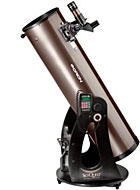 How about the telescope you’ve always longed for? You may already have a telescope, but for one reason or another, it may not be the right one for you. For me, there is the “Goldilocks Telescope”: not too large, not too small, but just right. After many decades in astronomy and having owned many telescopes, the perfect telescope for me is the Orion SkyQuest XT10 IntelliScope. A 12-inch Dob is just a little bit too big for me. I like to be able to sit down while observing: the view is steadier and I can see a lot more. Smaller apertures just don’t satisfy. 10 inches is just right. I prefer a Dobsonian mount because it’s easier to use and lighter in weight than an equatorial. And I’m hooked on the IntelliScope controller. After decades of finding things in the sky the hard way, I love the luxury of being able to take a look at anything in the sky at a moment’s notice, no star atlas or star hopping required. How about the telescope you’ve always longed for? You may already have a telescope, but for one reason or another, it may not be the right one for you. For me, there is the “Goldilocks Telescope”: not too large, not too small, but just right. After many decades in astronomy and having owned many telescopes, the perfect telescope for me is the Orion SkyQuest XT10 IntelliScope. A 12-inch Dob is just a little bit too big for me. I like to be able to sit down while observing: the view is steadier and I can see a lot more. Smaller apertures just don’t satisfy. 10 inches is just right. I prefer a Dobsonian mount because it’s easier to use and lighter in weight than an equatorial. And I’m hooked on the IntelliScope controller. After decades of finding things in the sky the hard way, I love the luxury of being able to take a look at anything in the sky at a moment’s notice, no star atlas or star hopping required.
And now for something completely different: Refractors 101
Suppose you’ve followed the advice I usually give to beginners, and have bought a nice Dobsonian telescope. You still hear a lot about how wonderful refractors are, and your curiosity is piqued. Although a Dob does a wonderful job of allowing you to observe nearly everything in the sky, it somehow doesn’t look like a real telescope. You’ve studied all those cool looking refractors in the Orion catalog, and you’re starting to drool…
A refractor works on different principles than a reflector. Instead of being bounced around by mirrors, in a refractor the light passes through the lenses. This means that more light passes through the telescope to your eye, but the down side is that the main lens in a refractor acts as a prism, and introduces something called chromatic aberration (or false color) into the telescope. The earliest refractors suffered from extreme chromatic aberration, but early in the nineteenth century opticians learned to combine lenses to eliminate much of this aberration. 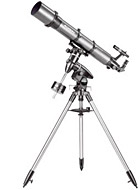 Such compound lenses were known as achromatic lenses, and used a combination of a convex crown glass and a concave flint glass to cancel out the chromatic aberration. Some aberration still remained, and in the late twentieth century this was corrected either by using triple lenses, or exotic materials like fluorite crystals. These lenses were known as apochromatic lenses, or “apos,” and were also known for being very expensive. Such compound lenses were known as achromatic lenses, and used a combination of a convex crown glass and a concave flint glass to cancel out the chromatic aberration. Some aberration still remained, and in the late twentieth century this was corrected either by using triple lenses, or exotic materials like fluorite crystals. These lenses were known as apochromatic lenses, or “apos,” and were also known for being very expensive.
Nowadays you can choose from a wide variety of refractors at a wide variety of prices. On the whole, refractors tend to be quite a bit more expensive than reflectors of the same size, but people are happy to pay the extra money because of the clarity and contrast of the images in a good refractor.
Achromatic refractors range from fairly inexpensive 60 mm refractors to some very large and fine instruments. I particularly like the Orion® SkyView Pro 120mm EQ Refractor Telescope. This telescope is large enough to give crisp contrasty views of the planets, and also does a fine job on the brighter deep sky objects.
 Because of its relatively short focal ratio, f/8.3, it shows quite a bit of chromatic aberration, so I recommend an Orion® V-Block Anti-Fringing Telescope Filter to clean up the residual color when observing the Moon and planets. Because of its relatively short focal ratio, f/8.3, it shows quite a bit of chromatic aberration, so I recommend an Orion® V-Block Anti-Fringing Telescope Filter to clean up the residual color when observing the Moon and planets.
Until recently, apochromatic refractors were priced beyond the ability of most people to afford, but recently their prices have dropped to much more reasonable levels. Orion now offers two lines of apochromatic refractors. First, there is the ED series, available in 80 mm, 100 mm and 120 mm sizes. I own both the 80 mm and 100 mm sizes myself. The 80 mm I use mainly for nature viewing from my deck and quick looks at astronomical objects on nights when it’s too cold or I’m too lazy to set up my larger telescopes. I have it mounted on an Orion VersaGo altazimuth mount, which makes it particularly easy to pick up and move around. The 100 mm I use for more serious solar, lunar, and planetary observing, thanks to its larger aperture and longer focal length.
Recently Orion has released a new series of apochromats, known as the EON series. These come in 72 mm, 80 mm, and 120 mm apertures, and are notable for their sleek black finish and superbly machined focusers. I tested the 120 mm version a few months ago <starrynight.com/sntimes/2008/07/index.html#art1> and found it to be one of the finest telescopes I’ve ever had the pleasure of using.
So, although a nice Dobsonian will do the job very well, there is a special pleasure from using a fine refractor like the ones I’ve described here. When I sit at the eyepiece of an equatorially mounted refractor, I feel at one with the great observers of yesteryear, using a classic telescope on a classic mount. It’s a very special feeling!
Geoff Gaherty
Geoff has been a life-long telescope addict, and is active in many areas of visual observation; he is a moderator of the Yahoo "Talking Telescopes" group.
[Top of Page]

For meteor observers, the presence of an almost-full Moon cast a bright pall on this month's performance of the Geminid Meteor Shower, normally one of the best meteor displays of the year. But another very good meteor shower may be right around corner. And for this one, the Moon will not play a factor at all.
So, get out your 2009 calendar and put a big circle around Saturday morning, Jan. 3
That's the expected peak date for the Quadrantids, a notoriously unpredictable meteor display. In 2009, peak activity is due to occur in the pre-dawn hours of Jan. 3 and will strongly favor western North America. If the "Quads" reach their full potential, observers blessed with clear, dark skies could be averaging one or two meteor sightings per minute in the hour or two prior to the break of dawn.
The Quadrantid (pronounced KWA-dran-tid) meteors provides one of the most intense annual meteor displays, with a brief, sharp maximum lasting but a few hours. Adolphe Quetelet of Brussels Observatory discovered the shower in the 1830's, and shortly afterward it was noted by several other astronomers in Europe and America.
The meteors are named after the obsolete constellation Quadrans Muralis the Mural or Wall Quadrant (an astronomical instrument), depicted in some 19th-century star atlases roughly midway between the end of the handle of the Big Dipper and the quadrilateral of stars marking the head of the constellation Draco. (The International Astronomical Union phased out Quadrans Muralis in 1922.)
Usually difficult to see
Unfortunately, many factors combine to make the peak of this display difficult to observe on a regular basis.
- Peak intensity is exceedingly sharp: meteor rates exceed one-half of their highest value for only about 8 hours (compared to two days for the August Perseids). This means that the stream of particles that produce this shower is a narrow one – apparently derived within the last 500-years from a small comet. The parentage of the Quadrantids had long been a mystery. Then Dr. Peter Jenniskens, an astronomer at the SETI Institute in Mountain View, Calif., noticed that the orbit of 2003 EH1 – a small asteroid discovered in March 2003 – ''falls snug in the shower.'' He believes that this 1.2 mi. (2 km.) chunk of rock is the source of the Quadrantids; possibly this asteroid is the burnt out core of the lost comet C/1490 Y1.
- As viewed from mid-northern latitudes, we have to get up before dawn to see the Quadrantids at their best. This is because the radiant – that part of the sky from where the meteors to emanate – is down low on the northern horizon until about midnight, rising slowly higher as the night progresses. The growing light of dawn ends meteor observing usually by around 7 a.m. So, if the "Quads" are to be seen at all, some part of that 8-hour active period must fall between 2 and 7 a.m.
- In one out of every three years, bright moonlight spoils the view.
- Over northern latitudes, early January often sees inclement/unsettled weather.
It is not surprising then, that the Quadrantids are not as well-observed as some of the other annual meteor showers, but 2009 could be an exception.
Excellent prospects in 2009
According to the International Meteor Organization, maximum activity this year is expected on 4:50 a.m. Pacific Standard Time on Jan. 3. For those across the western half of the United States and Canada, the radiant will soar high in the eastern sky just prior to the onset of morning twilight. Over the eastern United States and Canada, the spike of activity is predicted to come after sunrise.
Quadrantid meteors are described as bright and bluish with long silvery trains. Some years produce a mere handful, but for favorably placed observers, an excellent meteor display may be in the offing; at greatest activity, Quadrantid rates will likely range from 30 to 60 per hour for eastern parts of the U.S. and Canada, to perhaps 60 to 120 per hour for the western United States and Canada. For those in Europe, the shower's sharp peak will likely come long after sunrise. Nonetheless, hourly rates of perhaps 15 to 30 may still be seen.
As far as the moon is concerned, it will not be a factor at all this year. It's a waxing crescent, two days from first quarter phase and will have set around 11 p.m. local time on Friday, Jan. 2, leaving the rest of the night dark for meteor watching.
Joe Rao
SPACE.com Skywatching Columnist
Joe serves as an instructor and guest lecturer at New York's Hayden Planetarium. He writes about astronomy for The New York Times and other publications, and he is also an on-camera meteorologist for News 12 Westchester, New York.
[Top of Page]

Visible towards the southern horizon from winter through spring in the northern hemisphere, Orion is one of the most easily recognizable and beloved constellations.
By far, the most popular celestial gem in the constellation of Orion is M42, The Great Orion Nebula. Although it is 1500 light-years away, M42 is a great target to view in small telescopes. This is due not only to its brightness, but also to its wonderful cloud structure, which in telescopes takes on a clearly three-dimensional shape.
Observers new and old come back to M42 time and time again because of the wealth of detail visible: pinpoint stars hang among uncanny, ghostly tendrils of glowing hydrogen that stream across space for trillions of miles.
Astronomers call M42 a stellar nursery; when you look at this giant gas cloud you are seeing what our own solar system might have looked like billions of years ago. The nebula's reddish coloration (visible only in photographs) betrays the ionized hydrogen that predominates the composition of the cloud, but carbon monoxide and other complex molecules have also been detected. When viewed through a large telescope, the cloud takes on a wonderful greenish hue.
T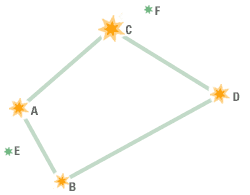 he energy that keeps the nebula glowing so bright comes from the very hot, young stars in the brightest part of the cloud. Known as the Trapezium, this formation of four stars (from west to east: A, B, C, and D) is visible in most backyard telescopes. he energy that keeps the nebula glowing so bright comes from the very hot, young stars in the brightest part of the cloud. Known as the Trapezium, this formation of four stars (from west to east: A, B, C, and D) is visible in most backyard telescopes.
A fun challenge for amateur astronomers is to "bag" the two 11th magnitude E and F stars, shown here in green. Their proximity to far brighter stars makes them difficult to separate on nights of so-so seeing. On great nights, discerning the E and F stars is a good test of your telescope's optics.
More Targets
The Horsehead Nebula was made famous from its beautiful photographs – it really does resemble what its name implies! The Horsehead can be found just below Alnitak (the leftmost/easternmost star in Orion's belt). The Horsehead is an extremely difficult target for medium aperture telescopes, and requires steady and dark skies to be seen even in a larger telescope.
A far easier nebular target in the same area can be found above Alnitak: Located above Orion's belt, M78 belongs to the same large cloud of gas and dust as the main Orion nebula (M42). It has 2 companion nebulae (NGC 2067 & 2071). All 3 are reflection nebulae, and M78 is in fact the brightest reflection nebula. It is visible in binoculars but best seen through a telescope.
NGC 2022 is a bright planetary nebula: a dying sun peeling off its outer shell. Because planetary nebulae are best viewed at high magnification, you should start out low (40x) to find the object, and then try 100x and 200x. The name "planetary" is misleading, as these objects are not planets at all but stars at the end of their life cycle. However, they do look something like cloudy planets, and this fact confused earlier observers whose incorrect naming convention has stayed with us to this day.
NCG 2174 is a bright but diffuse emission nebula, a cloud of hydrogen gas very close to a young hot star (or multiple stars). In such clouds, energy from the stars heats up the hydrogen to 10,000°K until it glows with the distinctive red color one can see in long-exposure photographs.
Betelgeuse is the only red star in Orion. Not only does this make it easy to identify, it also tells us we are looking at a giant star.
Betelgeuse (pronounced beetle juice by most astronomers) derives its name from an Arabic phrase meaning "the armpit of the central one."
The star marks the eastern shoulder of mighty Orion, the Hunter. Another name for Betelgeuse is Alpha Orionis, indicating it is the brightest star in the winter constellation of Orion. However, Rigel (Beta Orionis) is actually brighter. The misclassification happened because Betelgeuse is a variable star (a star that changes brightness over time) and it might have been brighter than Rigel when Johannes Bayer originally categorized it.
Betelgeuse is an M1 red supergiant, 650 times the diameter and about 15 times the mass of the Sun. If Betelgeuse were to replace the Sun, planets out to the orbit of Mars would be engulfed!
Betelgeuse is an ancient star approaching the end of its life cycle. Because of its mass it might fuse elements all the way to iron and blow up as a supernova that would be as bright as the crescent Moon, as seen from Earth. A dense neutron star would be left behind. The other alternative is that it might evolve into a rare neon-oxygen dwarf.
Betelgeuse was the first star to have its surface directly imaged, a feat accomplished in 1996 with the Hubble Space Telescope.
On the western heel of Orion, the Hunter, rests brilliant Rigel. In classical mythology, Rigel marks the spot where Scorpio, the Scorpion stung Orion after a brief and fierce battle. Its Arabic name means the Foot.
Rigel is a multiple star system. The brighter component, Rigel A, is a blue super giant that shines a remarkable 40,000 times stronger than the Sun! Although 775 light-years distant, its light shines bright in our evening skies, at magnitude 0.12.
Telescope observers should be able to resolve Rigel’s companion, a fairly bright 7th magnitude star.
A heavy star of 17 solar masses, Rigel is likely to go out with a bang some day, or it might become a rare oxygen-neon white dwarf.
Don’t forget to compare the colors of Betelgeuse and Rigel on your next outing under the stars!
Sean O'Dwyer, Starry Night® Times Editor
Pedro Braganca, Content Director, Starry Night®
Sean O'Dwyer
Starry Night® Times Editor
[Top of Page]

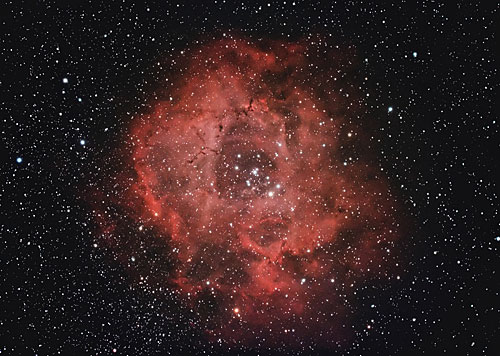
Rosette Nebula by W. Garrett Grainger, Jr.
November 27, 2008
Imaging scope was Orion ED80
Canon Rebel XT - Hap Griffin Modified
71 x 120s
Guided with PHD & EQMOD
IDAS LPS Filter
IP Vista Camera Control, IP 3.75b3, PS CS3.
PRIZES AND RULES:
We would like to invite all Starry Night® users to send their quality astronomy photographs to be considered for use in our monthly newsletter.
- Featured submissions (best of month) will receive a prize of $75 USD.
Please read the following guidelines and see the submission e-mail address below.
- Format: Digital images in either JPG, GIF or TIFF format.
- Size: 700 pixels wide maximum.
- File size should be less than 2 MB.
- Include a caption: Your full name, location where photo was taken and any interesting details regarding your photo or how you took it. Please be brief.
- Important notes: We may edit captions for clarity and brevity. We reserve the right to not use submissions. In submitting your image or images to Imaginova®, you agree to allow us to publish them in all media—on the Web or otherwise—now and in the future. We'll credit you, of course. Most important, you'll have the satisfaction of sharing your experience with the world!
- Send images, following the above guidelines, to photo@starrynight.com (by sending an image you agree to the above terms, including Imaginova®’s right to publish your photos). Please do not send .ZIP files as they will not reach us.
[Top of Page]
|
 |
 |
 |
 |
 |
 |
 |
Large Scale Structure of the Universe: Starry Night® Files

Explore the large scale structure of the universe with this set of Starry Night® files. Available for version 6.x.
|
 |
 |
Simply uncompress and enjoy!
Pedro Braganca
Content Director,
Starry Night®
|
 |
 |
 |
 |
 |
 |
 |
A guided video tour of celestial events visible this month.
• Click Here to Download
|
 |
 |
 |
 |
 |
 |
 |
Prepare for the International Year of Astronomy 2009. Details and event listings available at
Details and event listings available at <astronomy2009.org>
Pedro Braganca
Content Director,
Starry Night®
|
 |
 |
 |
 |
 |
 |
 |
Moon Phases
 Sun., Jan. 4 Sun., Jan. 4
First Quarter Moon, 6:56 a.m.
The Moon started its current phase cycle with New Moon on December 27, and has now completed one quarter of its orbit. Look for it high in the southern sky at sunset.
 Sat., Jan. 10 Sat., Jan. 10
Full Moon, 10:27 p.m.
Not everyone realizes this, but there is a big difference through the year as to where the Full Moon appears. It's always highest at about local midnight (not adjusting for Summer or Daylight Time), but it is actually much higher in Winter than in Summer. In fact, the Full Moon in December and January are the highest of the year, just the opposite of the Sun, which is lowest for the year. Different cultures had names for the Full Moon of January. Among the American Indian and First Nations Peoples of North America, there were numerous names. Among them, the Lakota Sioux and Mohawk names were particularly telling: "Moon of frost in the Tipi," and "Big Cold Moon", respectively.
 Sat., Jan. 17 Sat., Jan. 17
Last Quarter Moon, 9:46 p.m.
The Last Quarter is the least known because of its late-night, early-morning habits. Most have gone to bed by the time it rises (roughly midnight locally), and few notice it in the daylight sky the next day. This month the actual moment of "last (or 3rd) quarter" comes before the Moon has risen throughout most of North America, but you can see it late, or else in the southern sky tomorrow morning.
 Mon., Jan. 26 Mon., Jan. 26
New Moon, 2:55 a.m.
The Moon passes the Sun, and of course the brilliance of the Sun prevents us from viewing -- not to mention that both are below the horizon at the exact moment. But look for it on Tuesday evening as an extremely thin crescent in the west-southwestern sky at dusk (viewing will be easier on Wednesday evening).
Observing Highlights
Sat., Jan. 3
Quadrantid Meteors, 8 a.m.
The peak occurs after sunrise for eastern North America, but the conditions otherwise are not too bad for this little known but sometimes impressive shower. Several hours before dawn the radiant is high to the North in the constellation Bootes. There is no Moon to interfere, but this shower has a sharp peak, so the closer to the time of peak (8 a.m. Eastern, 5 a.m. Pacific), the better. Observers farther West are favored, but even Eastern observers could see some. Keep in mind that meteor showers are exceptionally fickle and hard to predict.
Planets
Mercury is always a challenge—it's just too close to the Sun to be easily seen. Low in the western twilight at the beginning of the month, it rapidly drops back into the solar glare, emerging near Mars, in the morning sky, at the end of the month. However, it likely is simply too close to the Sun to be seen before the sky gets too bright.
Venus has no rival in the early evening sky. It is dazzlingly bright and hard to miss if the sky is clear and you are facing the southwest as it gets dark. On the 14th, it is at its greatest elongation East, meaning that it is at its best in the early evening southwestern sky. Look for the Moon nearby on the 29th and 30th.
Mars is still too low in the morning twilight to be an easy target. It is very low in the southeastern sky, near the Sagittarius-Capricornus border, but likely too close to the Sun to be seen.
Still lingering in the western evening twilight, at the beginning of the month Jupiter is difficult or impossible to see (in Sagittarius) in January. It passes the Sun on the 24th, moving from the evening sky to the morning sky.
Saturn is your best bet for observing in the late evening after Venus goes down. There simply are no other planets to observe until Mars rises shortly before dawn. Saturn is in Leo, where it has been for some time and where it will remain until the Fall. Interesting for telescopic observers, Saturn's Rings are currently turned edgewise to Earth, and may be at time difficult to observe. Look for it rising in the late evening eastern sky.
Dates
Thu., Jan. 1
Saturn begins retrograde motion, 3:00 p.m.
The Earth travels faster in its orbit than Saturn or any of the Outer Planets, and occasionally seems to catch up to and pass them, as viewed from the Sun. Geometrically, when this happens, an observer on Earth sees the Outer Planet stop its forward motion (West to East) and for several weeks to several months appear to move backward (East to West) in what is known as "retrograde motion." Saturn begins retrograde motion today, in which it continues until May 17.
Sun., Jan. 4
Mercury at greatest elongation East , 8:25 a.m.
Mercury is as far East as it gets from the Sun for the current orbit, which means that it is visible in the evening western sky. However, it is only 19 degrees from our local star, and its lowness to the southwestern horizon makes it a challenge to observe.
Sun., Jan. 4
Earth at Perihelion, 10:43 a.m.
Contrary to what might seem common sense, the Earth is closest to the Sun in early January, and farthest in early July. This disproves the common misconception that Earth's varying distance from the Sun causes the seasons, because if it did, we in the Northern Hemisphere would enjoy beach holidays at Christmas and snow in July. No, the Earth's seasons are caused by the relative tilt of the planet on its axis, not the distance to the Sun. On this date, our planet is at a distance of 0.983267 Astronomical Units from the Sun, or approximately 1.7 percent nearer than the average. That amounts to 91,400,757 miles or 147,095,260 kilometers. (By contrast, on July 3 this year the distance is 94,505,103 miles or 152,091,221 kilometers.)
Wed., Jan. 7
Moon-Pleiades, 2 p.m.
The Moon passes less than a degree North of the Pleiades. Although the closest approach is unobservable in broad daylight, the two still are close in the eastern sky at nightfall.
Sat., Jan. 10
Moon at Perigee, 5:57 a.m.
When the Moon is at perigee (its closest point to the Earth during the current cycle), its gravitational effect on Earth is at its greatest. The Moon's greatest gravitational effect on Earth is in the production of the tides, so when perigee occurs near the time of Full or New Moon, the tides, known as perigean tides, can be exceptionally large. At this point the Earth is about 56 Earth radii (357,497 km or 222138 miles) away from our planet.
Wed., Jan. 14
Venus at greatest East, 4:24 p.m.
Being closer to the Sun than the Earth, Venus is in a smaller orbit, which makes it appear to oscillate back and forth from one side of the Sun to the other. This means that it regularly swings from the western (evening) side to the eastern side (morning) through out the year. Today it is 47 degrees to the East of the Sun, meaning that it is quite well-placed in the evening twilight southwestern sky -- and quite bright!
Thu., Jan. 15
Moon/Saturn, 7:36 a.m.
The Moon passes about 6 degrees south of Saturn. This is best seen in the South to Southwest sky shortly before dawn.
Tue., Jan. 20
Mercury at Inferior Conjunction, 10:59 a.m.
You cannot see this, as Mercury is too near the Sun. However, it marks the point where the planet moves from the evening sky to the morning sky, where sharp-eyed observers can catch it near Mars in the last week of the month.
Wed., Jan. 21
Moon/Antares, 8 a.m.
A thin Waning Crescent Moon passes very close to Antares before dawn from most of North America, the closest approach coming after sunrise in eastern locations. However, this is seen as an occultation (like an eclipse by the Moon) from the eastern Pacific and parts of South America and the South Atlantic.
Sat., Jan. 24
Jupiter in conjunction, 12:44 a.m.
Just as Mercury passed conjunction on Tue., Jupiter tonight invisibly (maybe "unobservably" is a better word!) moves from the evening side of the Sun to the morning, where you can catch it (if you can) around mid-February.
Mon., Jan. 26
Annular Solar Eclipse, 3:00 a.m.
Unfortunately, this is not visible at all from any location in the Americas or Europe. The path runs from the South Atlantic, across the Indian Ocean to Malaysia.
Fri., Jan. 30
Moon/Venus, 6:12 a.m.
The thin Crescent Moon passes north of Venus at about 6 a.m. on Fri., but neither object will visible at that time for North American or European observers. Instead, look to the western heavens just as it gets dark on Thursday and Friday evenings.
As always, there's more to explore on NightSky.
Data for this calendar have been derived from a number of sources including the Observer's Handbook 2008, 2009 of the Royal Astronomical Society of Canada, Starry Night® software, and others. Only events with a reasonable possibility for Northern Hemisphere observers, or those events with some other significance, are given. All times shown are U.S. Eastern Time.
|
 |
 |
 |
 |
 |
 |
 |
Join the Imaginova® Affiliate Program
If you publish a space or astronomy Web site or blog, earn extra cash by promoting Starry Night® on your Web site.
Click here to learn more!
It's easy to join and it's free!
|
 |
 |
 |
 |
 |
 |
 |
Send us your feedback
Do you have a question, comment, suggestion or article idea to pass along to Starry Night® Times?
Click here to get in touch with us.
|
 |
 |
 |
 |
 |
 |
 |
Starry Night® is the world's leading line of astronomy software and DVDs. Visit starrynight.com to see all the great products we offer for everyone from novice to experienced astronomers.
You have received this e-mail as a trial user of Starry Night® Digital Download or as a registrant at starrynight.com.
Starry Night® is a division of Imaginova® Corp.
To unsubscribe, click here.
To subscribe, sign up here.
Imaginova® Corp.
470 Park Ave South
9th Floor
New York, NY 10016
|
 |
 |
|

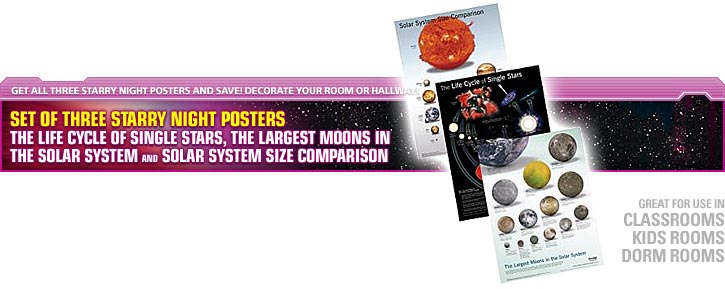



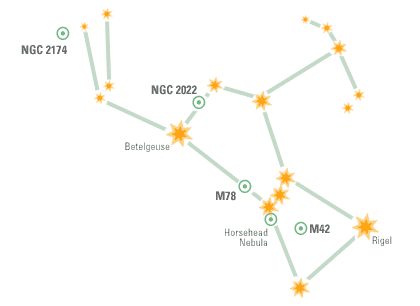
 he energy that keeps the nebula glowing so bright comes from the very hot, young stars in the brightest part of the cloud. Known as the Trapezium, this formation of four stars (from west to east: A, B, C, and D) is visible in most backyard telescopes.
he energy that keeps the nebula glowing so bright comes from the very hot, young stars in the brightest part of the cloud. Known as the Trapezium, this formation of four stars (from west to east: A, B, C, and D) is visible in most backyard telescopes.


